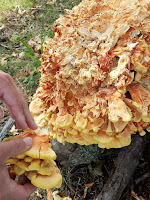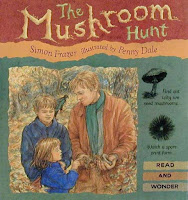Mushrooms: The Fun Fungus among Us
Have you ever heard of Chicken of the Sea? How about… Chicken of the Woods? Neither have anything to do with poultry. The former is a seafood brand, and the latter is actually a type of mushroom! I first learned of these mushrooms a few years ago at a farmer’s market in Wildwood, NJ. My husband is not a fan of mushrooms’ texture, but the mushroom hunter assured us that we’d be pleasantly surprised. I brought it home, sautéed it in a pan, and… it was delicious! It had none of the usual mushy mushroom texture and instead was quite firm and meaty. Flash forward to the spring of 2020, when we started watching the show Filthy Riches , which spotlights individuals hunting and foraging for eels, bloodworms, tree burls, and wild mushrooms! Our interest in chicken of the woods - and mushroom-hunting in general - was sparked once again. Wanting to see if we could find chicken of the woods – or any of the mushrooms we’d learned about - my husband, 2.5-year-old daughter, and I took some family walks around our neighborhood and in nearby parks. To our surprise and delight, we did! While it was only one cluster of chicken of the woods (at the school playground near our house, surprisingly!), we spent many enjoyable hours walking around and finding all sorts of other mushrooms.
A WORD OF WARNING : Mushrooms can be highly poisonous ! DO NOT pick and eat mushrooms that you find unless you are absolutely certain they are safe. All edible mushrooms have look-alikes that are poisonous, some even deadly, so don’t take chances . It’s also best to forage with an expert, such as can be found through the local mycological association. (Mycology is the study of mushrooms and fungi.) That being said, looking for them is a fun activity to do with your family during the summer and fall, the main mushroom seasons here in the northeast. We had fun searching, taking pictures, and just having that extra motivation to get out of our house and walk around the local parks. You’ll be amazed at how many different types, sizes, shapes, and colors of mushrooms and fungus you’ll find!
Mushrooms to look for by season:


Lion's Mane (Hericium erinaceus) seen while walking in Lawrenceville

Possibly Conocybe tenera. (I’ve attempted to ID the mushrooms we found, but it’s not easy!)
-
Spring
-
Morel (
Morchella
)
-
Morel (
Morchella
)
-
Summer
-
Vase-shaped mushroom (
Catharellus
and
Craterellus
)
-
Chicken of the Woods, a.k.a. Sulphur Shelf Mushroom (
Polyporus sulphureus
)
-
Teeth Fungus (
Hericium
and
Dentinum
)
-
Meadow Mushroom (
Agaricus campestris
)
-
Rodman’s Mushroom (
Agaricus bitorquis
)
-
Puffball (
Calvatia
,
Calbovista
, and
Lycoperdon
)
-
Vase-shaped mushroom (
Catharellus
and
Craterellus
)
-
Fall
-
Bolete (
Boletus ,
Suillus , and
Leccinum
)
-
Hen of the Woods (
Polyporus frondosus
)
-
Many-capped Polypore (
Polyporus umbellatus
)
-
Cauliflower Fungus (
Sparassis radicata
)
-
Curly Sparassis (
Sparassis crispa
)
-
Shaggy-Mane (
Coprinus comatus
)
-
Oyster, Lilac, and Angel Wings (
Pleurotus
)
-
Bolete (
Boletus ,
Suillus , and
Leccinum
)
-
Winter
- Not much to find, though possibly some oyster mushrooms ( Pleurotus ostreatus), lilac-spored mushrooms ( Pleurotus sapidus ) or winter mushrooms ( Flammulina velutipes ) that may sprout during winter thaws.
Fun mushroom facts:

Possibly Gloeophyllum sepiarium (I’ve attempted to ID the mushrooms we found, but it’s not easy!)

Possibly Leucoagaricus americanus (I’ve attempted to ID the mushrooms we found, but it’s not easy!)

An unidentified mushroom I saw in January as I was writing this post!

Unidentified mushroom we saw.
-
Water is a key factor in mushroom growth, and mushrooms spring up quickly after it rains. Early Greeks believed lightning bolts striking the ground during rainstorms created mushrooms! (Marteka, 1980, p. 8)
-
Mushrooms can be very strong! They have pushed their way through 3” asphalt and broken concrete floors. In England, an 83-pound stone slab 2 feet wide pushed free of its concrete and lifted 2” off the ground… all by two small meadow mushrooms! (Marteka, 1980, p. 8-9)
-
Mushrooms are more than they appear; a lot of the plant is underground. We only see the fruiting part of the plant, the part that releases spores for reproduction. Most of the mushroom plant consists of a network of tiny, root-like threads called
mycelium
. When one mycelium meets another, they merge into one giant network.
-
There are more than 5,000 mushrooms in the U.S., coming in all shapes and sizes, in various habitats. They also fall on a spectrum of edibility, from delicious, to bland, to inedible, to poisonous (a very small number). (Marteka, 1980, p. 14)
-
One toxin found in false morel mushrooms,
monomethylhydrazine
(MMH), is identical to a missile and rocket fuel propellant used in the U.S. space program and by the military. (Marteka, 1980, p. 19)
-
In nineteenth-century France, chicken of the woods mushroom (
Polyporous sulphureus
) was used by French clothiers to make a yellow dye. Its nickname chicken of the woods comes from its resemblance to a sitting hen. (Marteka, 1980, pp. 89, 94)
-
The Chinese began cultivating mushrooms around 2,000 years ago! (Arnold, 1997, p. 42)
- Texas leaf-cutting ants cultivate mushrooms in their underground nests! They cut leaves to feed the mushrooms and ventilate them by opening and closing tunnels as needed. This is their only known source of food. (Arnold, 1997, p. 42)
Resources to Get You Started:
Below are some books and a TV show (all available for free through the library), and websites where you can learn about mushrooms and how to identify them. The library also has children’s materials on mushrooms, so they can join in the fun of learning, too! Happy hunting!
Children’s Resources:
- Curiosity Quest: Mushrooms. A 30-minute TV episode by Joel Greene, available through the library via hoopla.
To access this, you will need to log in to hoopla with your library card number and create a free account. If you are using a mobile device, you will need the hoopla app, available for free in your app store.
-
Allen, Missy & Michel Peissel. (1993).
Dangerous Plants and Mushrooms. Chelsea House
Call No : J 581.65 ALL
ISBN: 9780791017876
A perfect book for the kid who loves to read about poisonous/dangerous things. This covers a mix of mushrooms and other plants.
-
Arnold, Katya. (1997).
Katya’s Book of Mushrooms (K. Arnold, Illus.). Henry Holt and Company,
Call No .: J 589.2 ARN
ISBN: 9780805041361
-
Fowler, Allan. (1998).
Good Mushrooms and Bad Toadstools.
Children’s Press.
Call No .: ENF 579.6 FOW
ISBN: 9780516208084
A simple but informative look at mushrooms for younger kids (approx. PreK-1 st Grade).
-
Frazer, Simon. (1994).
The Mushroom Hunt
(P. Dale, Illus.). Candlewick Press.
Call No .: ENF 589.2 FRA 1955
ISBN: 9781564025005
-
Owings, Lisa. (2018).
From Spore to Mushroom. Lerner Publications.
Call No .: E 579.6 OWI 2018
ISBN: 9781512434415
A short, simple book on how mushrooms grow .
-
Twiddy, Robin. (2019).
Mushrooms and Fungi. KidHaven Publishing.
Call No .: J 579.6 TWI 2019
ISBN: 9781534528734
Adult Resources:
-
Jordan, Peter. (1999).
Mushroom Identifier: Illustrated Encyclopedia. Lorenz Books.
Call No .: 579.6022 JOR
ISBN: 9780754800088
-
Lincoff, Gary. (2017).
The Complete Mushroom Hunter: An Illustrated Guide to Foraging, Harvesting and Enjoying Wild Mushrooms: Including New Sections on Growing Your Own Edibles and Off-season Collecting. (Revised Edition). Quarry Books.
Call No .: 579.6 LIN 2017
ISBN: 9781631593017
-
Kibby, Geoffrey. (1993).
An Illustrated Guide to Mushrooms and Other Fungi of North America. Dragon’s World.
Call No .: NF 589.2 KIB (oversize collection)
ISBN: 9781850282532
*VERY well done artwork, and a helpful guide to identifying mushrooms.
-
Marteka, Vincent. (1980).
Mushrooms Wild and Edible: A Seasonal Guide to the Most Easily Recognized Mushrooms. W.W. Norton & Company.
Call No .: 641.3 MAR
ISBN: 9780393013566
An older book but VERY informative!
-
Rinaldi, Augusto & Vassili Tyndalo. (1985).
The Complete Book of Mushrooms. Crescent Books.
Call No .: 589 REN
ISBN: 9780517514931
-
Russell, Bill. (2017).
Field Guide to Wild Mushrooms of Pennsylvania and the Mid-Atlantic. The Pennsylvania State University Press.
Call No .: 579.6 RUS 2017
ISBN: 9780271077802
-
Turner, Nancy J. (2009).
The North American Guide to Common Poisonous Plants and Mushrooms. Timber Press.
Call No .: 581.6 TUR 2009
ISBN: 9780881929294
Websites:
-
NJ Mycological Association.
http://www.njmyco.org/
- A group dedicated to mycology, the study of mushrooms and fungi, in NJ. A good resource for meeting mushroom experts and going on finding forays.
- “New to Mushroom Hunting? Start Here!” (YouTube video, approx. 30 min.) https://www.youtube.com/watch?v=9tqKQ1GrEy4
-
Mushroom Appreciation -
https://www.mushroom-appreciation.com/#sthash.2HsBHNks.dpbs
- A mushroom-lover’s website. To quote the site: “The purpose of this site is to entertain and inform while celebrating our love of nature and fungi. We'll explore the science behind these mysterious organisms. We'll examine the thrill of their unexpected appearance and artistic beauty. Yet best of all, I'll present you with a ton of fun tips, recipes, and how-to guides in order to get the best out of your interactions with fungi.”
- Jennifer Crabtree, Lawrence Branch







Thanks for sharing valuable information about Mushrooms. I learned a lot from this information that would be very helpful, but all Mushrooms are not harmful for us. One of my friends ordered mushrooms from Agrinoon (Fujian) Ecological Agriculture Co. Ltd, which was of the highest quality. I also ordered it many times, which is great.
ReplyDelete